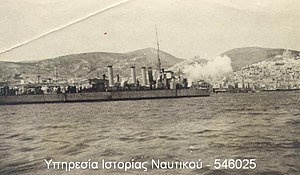Greek destroyer Leon

Destroyer Leon
|
|
| History | |
|---|---|
|
|
|
| Name: | Leon (ΒΠ Λέων) |
| Namesake: | lion |
| Ordered: | 1912 |
| Builder: | Cammell Laird, Birkenhead |
| Laid down: | 1911 |
| Launched: | 1 July 1911 |
| Commissioned: | 1912 |
| Decommissioned: | 15 May 1941 |
| Fate: | sunk at Souda Bay, Crete 1941 |
| General characteristics | |
| Class and type: | Wild Beast-class destroyer |
| Displacement: | 880 tons standard |
| Length: | 89.4 m (293 ft) |
| Beam: | 8.3 m (27 ft) |
| Draft: | 3 m (9.8 ft) |
| Propulsion: |
|
| Speed: | 31 knots (57 km/h) maximum (32 knots (59 km/h) after 1925) |
| Complement: | 58 |
| Armament: |
|
Leon (Greek: ΒΠ Λέων, "Lion") served in the Royal Hellenic Navy from 1912–1941.
The ship, along with her three sister ships of Wild Beast-class destroyers Aetos, Ierax and Panthir was ordered from England. They were purchased ready for delivery, each for the sum of £148,000, from the British shipyard Cammell Laird in Birkenhead, when the Balkan Wars seemed likely. These ships had originally been ordered by Argentina; Leon was originally named Tucumán.
During the Balkan Wars, the Royal Hellenic Navy purchased only the minimum amount of ammunition, 3,000 rounds. Torpedoes were not available for this class of ship, and for this reason these ships were initially named 'scouts' rather than 'destroyers'. Leon was in action during the Balkan Wars under Lieutenant Commander J. Razikotsikas, also on board was Squadron Commander Lieutenant Commander D. Papachristos.
During World War I, Greece belatedly entered the war on the side of the Triple Entente and, due to Greece's neutrality the four Wild Beast-class ships were seized by the Allies in October 1916, taken over by the French in November, and served in the French Navy from 1917-18. By 1918, they were back on escort duty under Greek colors, and was in action blockading the coasts of the Black Sea from Bosphorus up to Trebizond.
...
Wikipedia
